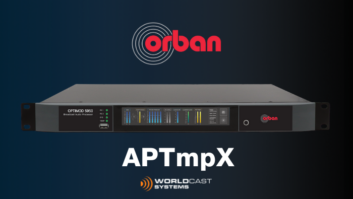Eventide Still Holds High Place in Effects Processing, Enables Users to Create Multiple Audio Environments
(click thumbnail)Product CapsuleThumbs up:
Big and powerful
Lots of useful, usable effects
Programmability
Digital and analog I/O
Thumbs Down:
Complex to the point of intimidation for some
Some programs disabled at high clock rates
For information contact Eventide in New Jersey at (201) 641-1200, fax (201) 641-1640 or visit the Web site at www.eventide.com
The Orville is the latest in a line of innovative effect processors from Eventide Inc. of Little Ferry, N.J., going all the way back to the days when the product lines were the Harmonizer, the Instant Flanger and the Omnipressor, and the company carried the name Eventide Clockworks.
Back then, having a Harmonizer in the rack meant you had arrived. Graphic EQs and an Orban spring reverb were nice, but a Harmonizer in the studio told the world “you-da-man.” That statement still holds true today.
With the Orville, Eventide brings to the feast a high-quality, 24-bit, dual-DSP processor with all the goods: reverb, ring modulation, flanging, delay, filtering and a heckuva fantastic sampling feature.
This much power comes with a price of $5,695, but folks wanting this kind of processing power will pay it happily for the edge it gives them in the studio.
While radio’s approach is “get it out the door fast,” the dedicated production person will want to leap beyond the factory presets and explore new possibilities. So this review, like the Orville manual itself, is being presented in two parts: operations and programming.
For the first part, we will concentrate solely on operations and we will delve into the possibilities presented by programming in the next issue.
Step up to the panel
The Orville faceplate maintains the familiarity offered by its siblings, the H3000 and DSP4000 – a quartet of soft keys with a concise display panel, program and parameter buttons, a direct-entry numeric keypad and that big beautiful Eventide KNOB.
The KNOB – capitalized even in Eventide literature – has been a fixture since the original model 910. The dial is far more satisfying and intuitive than nudging a set of numbers with a keypad, although the Orville gives you the option of doing either.
The back panel is decked out with jacks for AES/EBU or S/PDIF digital leads, balanced or unbalanced analog lines, MIDI devices and a foot pedal arrangement to modulate parameters in real time.
An RS232 serial port allows the Orville to talk to computers, providing mass storage and backup of programs and presets. At face value, this does not seem a big feature for the radio production studio, but you would be surprised how powerful this will be when creating your own programs.
No computer? No problem. Save your masterpiece presets to a MIDI sequencer or PCMCIA RAM card. The slot is under the keypad.
The Ins and Outs of Orville
Note there are four analog Ins and Outs. Remember, this is a dual-DSP box and you may use one Orville to fulfill two purposes simultaneously. Internal routing of the DSPs lets you run the Orville in series or parallel configurations.
The manual shows no less than nine different ways to combine analog and digital inputs and routings to accomplish complex processing tasks.
Even the “quick-start” section of the manual encompasses pages 22 through 34. Where many effect boxes can put their entire quick-start directions on a single laminated card, it really does take 13 pages to get to know the Orville. But don’t let this get in your way.
Here is what you need to know to start. First, tap the setup key (to the far right above the power switch) until you get to the audio menu. Set your audio input, either analog or digital. A digital input will sync up the Orville’s clock to the incoming sample rate. Otherwise, you will need to select an internal sample rate, nominally 44.1 or 48 kHz.
Do not set the Orville’s sample rate any higher than you have to. For one thing, nobody will hear 96 kHz over car speakers or clock radios. Plus the unit must borrow power from system resources and several programs will not run at higher clock speeds.
The presence or absence of a lightning bolt icon in the display shows which programs are affected.
Decide on the desired routing scheme – which inputs and outputs get directed to which DSPs – then fine-tune input levels. No sense having a state-of-the-art processor if distortion is going to creep in and wreck your day. Then, go to the Levels and Meter menu items to set things right.
Now comes the moment every Eventide user looks forward to: Enter the program area, use the cursor keys – the four arrow keys – to scroll through the programs, then tap the select key. The program loads into one of the DSPs. Use the DSP A/B key to load a program into the other DSP.
Remember that paralleling or following DSPs can create some powerful processing. If you have the unit, then you paid for both, so use them.
Fire it up
There are a number of remarkably creative presets included in the Orville, and many leave the old Max Headroom stutter effect in the dust.
Among my favorites is “16 mm Projector,” which combines the chatter of a classic high school Bell and Howell junker with a vocal filter. The surprise: Hit a soft key and both the projector and the voice slow down in pitch and stop with an mm-mmrup.
There is “Long Distance,” which fills the line with transatlantic noise, return echoes of your own voice and side tone chirps to accompany the echo. It plays like an old Churchill speech and it is brilliant.
“Adaptive Reverb” is a fairly clever reverb. The amount of reverb time dynamically adjusts to the pitch of your voice. Low tones give you long tails, while a high pitch gives you a tiled shower.
There is a solid complement of reverbs, classic reverb emulations such as EMT plates, a marvelous selection of choruses and flanges, vocoding and ring modulating, and a fistful of sci-fi effects to make you grin.
Of course, if you still want the Max Stutter, it’s still in there. So is “Doubletalk,” known as the Time Scrambler from the earliest Harmonizer units.
The unit has MIDI-controllable oscillators and a bunch of samplers too. Tie a MIDI keyboard to the Orville, set the unit up as a synthesizer, then go ahead and make some noise.
The Orville is remarkably fluent in MIDI and many effects are maximized when used as part of a MIDI rig.
Because the typical radio production room has not ventured far into MIDI territory, any mention here of the Orville’s prowess in this sphere would not be pertinent to the tasks of the modern production director. If you are interested in MIDI, however, you may always visit the Eventide Web site for details.
The Orville comes with a playful side as well. Dial up a few work environments complete with related ambient sounds. The traffic report simulation – a favorite from earlier units – drops in a synthetic aircraft whirr and makes the voice sound choppy, while a desktop intercom unit opens with an annoying bleep and a harshly filtered mic effect.
Another classic effect returning is the CB radio simulation, complete with squelched noise burst and distorted mic signal.
I’ve always joked that a CB simulation was never complete until Eventide invented a chip that gave the voice a characteristic trucker twang. However, given the advances in audio modeling technology, this may not be as farfetched as once thought.
Conclusion
If you have been used to working with rudimentary “quick set” processors such as the Alesis Nanoverb or Zoom 2001, the panel on the Orville may scare you off. It will be easy to feel helplessly adrift in a sea of parameters, menus and sub-menus, and utility pages difficult to back out of.
The only cure for this is to hoist the manual (all 300 or so pages of it) and get busy. The Orville may well carry the most processing power you have ever encountered in your career and it is up to you to harness that power.
The reward is breaking free of generic “rooms” and “plates” and creating interesting new sounds that will make your production the best in the market.
The Orville is not a set-and-forget effects box – it means business. And for the sake of your station’s bottom line, it may bring plenty of business.
In the next issue I’ll review the ins and outs of programming the Orville to create your own effect patches from scratch.













